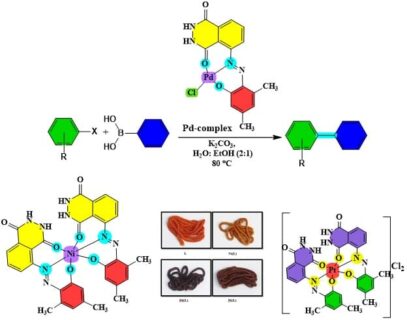Feasible and Simple Preparation of Pd (II), Ni (II), and Pt (IV) Complexes: Their Biological and Industrial Applications and Investigation of Pd (II) complex in Suzuki Reaction
Authors
Abstract
A novel ligand, (E)-5-((2-hydroxy-4,6-dimethylphenyl)diazenyl)-2,3-dihydrophthalazine-1,4-dione, was synthesized through the reaction of 3,5-dimethylphenol with the diazonium salt of 5-amino-2,3-dihydrophthalazine-1,4-dione. The ligand underwent characterization through the utilization of diverse spectroscopic methods, including UV-Vis, FT-IR, 13C and 1H-NMR, alongside Mass spectroscopy and microelemental analysis (Carbon, Hydrogen, Nitrogen, Oxygen). Metal chelates of transition metals were prepared and analyzed using elemental analysis, mass spectra, atomic absorption, UV-Vis, FT-IR spectral analysis, as well as conductivity and magnetic measurements. The investigation into the compounds’ nature was conducted by utilizing mole ratio and continuous contrast methods, where Beer’s law was adhered to over a concentration range of 1×10-4-3×10-4 mol/L. The determination of the molar absorptivity of the compound solutions was carried out. Analytical data analysis indicated that all complexes demonstrated a metal-ligand ratio of 1:2, with the exception of the palladium complex, which exhibited a 1:1 ratio. Physicochemical data indicated an octahedral structure for Pt (IV) and Ni (II) complexes, and a square planar structure for the Pd (II) complex. The Pd complex was utilized in a carbon-carbon Suzuki coupling reaction to evaluate the application of this complex. Furthermore, the biological activity of these complexes was assessed on the proliferation of human blood lymphocytes. The results demonstrated that the ligand inhibited cell division at varying levels, with the inhibition increasing with higher concentrations. Furthermore, the Pd complex caused a prolonged arrest during mitosis at the boundary between metaphase and anaphase, leading to the suppression of proliferation in the lymphocyte cell line. The stability of the dyes was assessed in terms of light exposure and resistance to detergents.
Highlights
· A novel azo ligand was synthesized from the reaction of 3,5-dimethylphenol and diazonium salts.
· The prepared ligands were metalated with Ni (II), Pd (II), and Pt (IV).
· The synthesized metal complexes were characterized using UV-Vis, FT-IR and etc.
· The Pd (II) complex was used in Suzuki cross coupling reaction.





